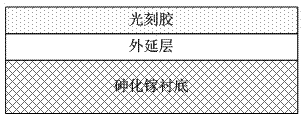Method for stripping and transferring gallium arsenide based epitaxial layer
A gallium arsenide-based, lift-off transfer technology, applied in the field of semiconductor technology, to achieve the effect of not easy to wrinkle or break, good uniformity, and not easy to fragment
- Summary
- Abstract
- Description
- Claims
- Application Information
AI Technical Summary
Problems solved by technology
Method used
Image
Examples
Embodiment 1
[0038] ① Soak the gallium arsenide-based epitaxial wafer and glass slide in diluted hydrochloric acid (HCl) for 60 seconds, then rinse with deionized water, and put them in a spin dryer for drying.
[0039] ② Spin-coat the positive photoresist on the front surface of the GaAs-based epitaxial wafer, the rotation speed is 5000 rpm, and the spin-coating time is 90 seconds.
[0040] ③ Put the GaAs-based epitaxial wafer coated with positive photoresist facing up on the heating plate, the temperature of the hot plate is 110 degrees Celsius, and the baking time is 5 minutes.
[0041] ④Take the gallium arsenide-based epitaxial wafer from the hot plate and stack it with the front of the glass slide, fix it with a fixture and put it into a bonding machine for bonding. The bonding temperature is 200 degrees Celsius and the bonding time is 60 minutes.
[0042] ⑤ After bonding, thin the back of the gallium arsenide substrate of the gallium arsenide-based epitaxial wafer to about 100 micron...
Embodiment 2
[0048] ① Soak the gallium arsenide-based epitaxial wafer and glass slide in diluted hydrochloric acid (HCl) for 30 seconds, then rinse with deionized water, and put them in a spin dryer for drying.
[0049]② Spin-coat positive photoresist on the front surface of the GaAs-based epitaxial wafer, the rotation speed is 1000 rpm, and the spin-coating time is 60 seconds.
[0050] ③ Put the GaAs-based epitaxial wafer coated with positive photoresist facing up on the heating plate, the temperature of the hot plate is 100 degrees Celsius, and the baking time is 2 minutes.
[0051] ④Take the gallium arsenide-based epitaxial wafer from the hot plate and stack it with the front of the glass slide, fix it with a fixture and put it into a bonding machine for bonding. The bonding temperature is 180 degrees Celsius and the bonding time is 30 minutes.
[0052] ⑤ After bonding, thin the back of the gallium arsenide substrate of the gallium arsenide-based epitaxial wafer to about 100 microns, an...
PUM
 Login to View More
Login to View More Abstract
Description
Claims
Application Information
 Login to View More
Login to View More - R&D
- Intellectual Property
- Life Sciences
- Materials
- Tech Scout
- Unparalleled Data Quality
- Higher Quality Content
- 60% Fewer Hallucinations
Browse by: Latest US Patents, China's latest patents, Technical Efficacy Thesaurus, Application Domain, Technology Topic, Popular Technical Reports.
© 2025 PatSnap. All rights reserved.Legal|Privacy policy|Modern Slavery Act Transparency Statement|Sitemap|About US| Contact US: help@patsnap.com



